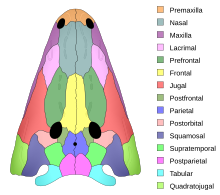
Temnospondyli or temnospondyls is a diverse ancient order of small to giant tetrapods—often considered primitive amphibians—that flourished worldwide during the Carboniferous, Permian and Triassic periods, with fossils being found on every continent. A few species continued into the Jurassic and Early Cretaceous periods, but all had gone extinct by the Late Cretaceous. During about 210 million years of evolutionary history, they adapted to a wide range of habitats, including freshwater, terrestrial, and even coastal marine environments. Their life history is well understood, with fossils known from the larval stage, metamorphosis and maturity. Most temnospondyls were semiaquatic, although some were almost fully terrestrial, returning to the water only to breed. These temnospondyls were some of the first vertebrates fully adapted to life on land. Although temnospondyls are amphibians, many had characteristics such as scales and armour-like bony plates that distinguish them from the modern soft-bodied lissamphibians.

Heterodontosaurus is a genus of heterodontosaurid dinosaur that lived during the Early Jurassic, 200–190 million years ago. Its only known member species, Heterodontosaurus tucki, was named in 1962 based on a skull discovered in South Africa. The genus name means "different toothed lizard", in reference to its unusual, heterodont dentition; the specific name honours G. C. Tuck, who supported the discoverers. Further specimens have since been found, including an almost complete skeleton in 1966.

Gerrothorax is an extinct genus of temnospondyl amphibian from the Triassic period of Greenland, Germany, Poland, Sweden, and possibly Thailand. It is known from a single species, G. pulcherrimus, although several other species such as G. pustuloglomeratus have been named in the past.

Mastodonsaurus is an extinct genus of temnospondyl from the Middle Triassic of Europe. It belongs to a Triassic group of temnospondyls called Capitosauria, characterized by their large body size and presumably aquatic lifestyles. Mastodonsaurus remains one of the largest amphibians known, and may have exceeded 6 meters in length.

Rhinesuchus is a large temnospondyl. Remains of the genus are known from the Permian of the South African Karoo Basin's Tapinocephalus and Cistecephalus assemblage zones, both belonging to the Beaufort Group. The skull of Rhinesuchus had a flat triangular shape with blunt snout similar to some of the other large temnospondyls, and had a palate filled with small sharp teeth, suggesting that it hunted fish. Also, the small eyes were on top of the head suggesting that it approached its prey from below.
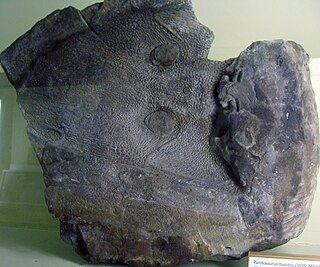
Parotosuchus is an extinct genus of capitosaurian temnospondyls within the family Mastodonsauridae. Fossils are known from the Early Triassic of Europe, Africa, Australia, and Antarctica. It was about 2 metres (6.6 ft) long and likely lived in aquatic environments such as lakes and rivers. Parotosuchus was covered in a scaly skin, unlike the smooth skin of modern-day amphibians, and probably moved with an eel-like motion in the water.

Batrachotomus is a genus of prehistoric archosaur. Fossils of this animal have been found in southern Germany and dated from the Ladinian stage of the Middle Triassic period, around 242 to 237 million years ago. Batrachotomus was described by palaeontologist David J. Gower 22 years after its discovery.
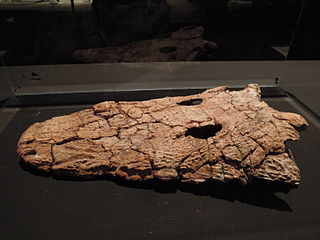
Eryosuchus is an extinct genus of capitosauroid temnospondyl from the Middle Triassic of northern Russia. It was a very large predator: the largest specimen known could reach up to 3.5 m (11.5 ft) in length, with a skull over 1 m long.

Rhinesuchidae is a family of tetrapods that lived primarily in the Permian period. They belonged to the broad group Temnospondyli, a successful and diverse collection of semiaquatic tetrapods which modern amphibians are probably descended from. Rhinesuchids can be differentiated from other temnospondyls by details of their skulls, most notably the interior structure of their otic notches at the back of the skull. They were among the earliest-diverging members of the Stereospondyli, a subgroup of temnospondyls with flat heads and aquatic habits. Although more advanced stereospondyls evolved to reach worldwide distribution in the Triassic period, rhinesuchids primarily lived in the high-latitude environments of Gondwana during the Guadalupian and Lopingian epochs of the Permian. The taxonomy of this family has been convoluted, with more than twenty species having been named in the past; a 2017 review recognized only eight of them to be valid. While several purported members of this group have been reported to have lived in the Triassic period, most are either dubious or do not belong to the group. However, at least one valid genus of rhinesuchid is known from the early Triassic, a small member known as Broomistega. The most recent formal definition of Rhinesuchidae, advocated by Mariscano et al. (2017) is that of a stem-based clade containing all taxa more closely related to Rhinesuchus whaitsi than to Lydekkerina huxleyi or Peltobatrachus pustulatus. A similar alternate definition is that Rhinesuchidae is a stem-based clade containing all taxa more closely related to Uranocentrodon senekalensis than to Lydekkerina huxleyi, Trematosaurus brauni, or Mastodonsaurus giganteus.
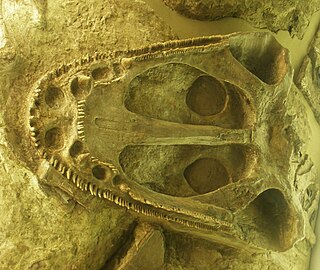
Mastodonsauridae is a family of capitosauroid temnospondyls. Fossils belonging to this family have been found in North America, Greenland, Europe, Asia, and Australia. The family Capitosauridae is synonymous with Mastodonsauridae.

Microposaurus is an extinct genus of trematosaurid temnospondyl. Fossils are known from the Cynognathus Assemblage Zone of the Beaufort Group in South Africa and the Rouse Hill Siltstone of Australia that date back to the Anisian stage of the Middle Triassic. These aquatic creatures were the short snouted lineage from Trematosaurinae.

Limnarchia is a clade of temnospondyls. It includes the mostly Carboniferous-Permian age Dvinosauria and the mostly Permian-Triassic age Stereospondylomorpha. The clade was named in a 2000 phylogenetic analysis of stereospondyls and their relatives. Limnarchia means "lake rulers" in Greek, in reference to their aquatic lifestyles and long existence over a span of approximately 200 million years from the Late Carboniferous to the Early Cretaceous. In phylogenetic terms, Limnarchia is a stem-based taxon including all temnospondyls more closely related to Parotosuchus than to Eryops. It is the sister group of the clade Euskelia, which is all temnospondyls more closely related to Eryops than to Parotosuchus. Limnarchians represent an evolutionary radiation of temnospondyls into aquatic environments, while euskelians represent a radiation into terrestrial environments. While many euskelians were adapted to life on land with strong limbs and bony scutes, most limnarchians were better adapted for the water with poorly developed limbs and lateral line sensory systems in their skulls.
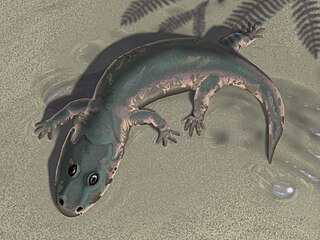
Cryobatrachus is an extinct genus of temnospondyl amphibian from the Early Triassic of Antarctica. The type species is Cryobatrachus kitchingi. It is known from a partial skull and an imprint of the skull roof, both found in the Fremouw Formation of the Transantarctic Mountains at about 85° south latitude and described in 1974. Many small bone fragments have also been identified, although they cannot be attributed with certainty to C. kitchingi. Cryobatrachus has been classified in the family Lydekkerinidae, as it is similar in appearance to the genus Lydekkerina from South Africa. Because only a small number of features distinguish it from other lydekkerinids, Cryobatrachus kitchingi has more recently been considered a nomen dubium, meaning that its distinction from other better-known species may be unwarranted.

Lydekkerina is an extinct genus of stereospondyl temnospondyl. It is the type genus of the family Lydekkerinidae. Fossils have been collected from Early Triassic deposits in South Africa and Australia. The type species is L. huxleyi, first described in 1889. While most other stereospondyls were semiaquatic, Lydekkerina was exclusively terrestrial.
Rotaurisaurus is an extinct genus of temnospondyls from the family Lapillopsidae. This genus is known only from an incomplete crushed skull and associated left jaw, together given the designation UTGD 87795. The generic name, Rotaurisaurus, is a combination of Latin words translating to "circle-eared lizard". This references the shape of its otic notches, which acquire a circular form due to being partially enclosed by the tabular bones at the back of the skull. The specific name, contundo, references the specimen's poor level of preservation, as it is derived from the Latin word for "squashed".
Wellesaurus is an extinct genus of mastodonsauroid temnospondyl. They were amphibious carnivores that lived in freshwater environments.
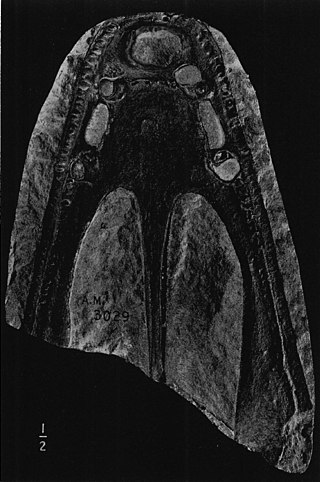
Stanocephalosaurus is an extinct genus of large-sized temnospondyls living through the early to mid Triassic. The etymology of its name most likely came from its long narrow skull when compared to other temnospondyls. Stanocephalosaurus lived an aquatic lifestyle, with some species even living in salt lakes. There are currently three recognized species and another that needs further material to establish its legitimacy. The three known species are Stanocephalosaurus pronus from the Middle Triassic in Tanzania, Stanocephalosaurus amenasensis from the Lower Triassic in Algeria, and Stanocephalosaurus birdi, from the middle Triassic in Arizona. Stanocephalosaurus rajareddyi from the Middle Triassic in central India needs further evidence in order to establish its relationship among other Stanocephalosaurs. Like other temnospondyls, Stanocephalosaurus was an aquatic carnivore. Evidence of multiple species discovered in a wide range of localities proves that Stanocephalosaurus were present all across Pangea throughout the early to mid Triassic.

Anaschisma is an extinct genus of large temnospondyl amphibians. These animals were part of the family called Metoposauridae, which filled the crocodile-like predatory niches in the late Triassic. It had large skull about 62 centimetres (24 in) long, and possibly reached 3 metres (9.8 ft) long. It was an ambush hunter, snapping up anything small enough to fit in its huge jaws. It was very common during the Late Triassic in what is now the American Southwest.

Manubrantlia was a genus of lapillopsid temnospondyls from the Early Triassic Panchet Formation of India. This genus is only known from a single holotype left jaw, given the designation ISI A 57. Despite the paucity of remains, the jaw is still identifiable as belonging to a relative of Lapillopsis. For example, all three of its coronoid bones possessed teeth, the articular bone is partially visible in lateral (outer) view, and its postsplenial does not contact the posterior meckelian foramen. However, the jaw also possesses certain unique features which justify the erection of a new genus separate from Lapillopsis. For example, the mandible is twice the size of any jaws referred to other lapillopsids. The most notable unique feature is an enlarged "pump-handle" shaped arcadian process at the back of the jaw. This structure is responsible for the generic name of this genus, as "Manubrantlia" translates from Latin to the English expression "pump-handle". The type and only known species of this genus is Manubrantlia khaki. The specific name refers to the greenish-brown mudstones of the Panchet Formation, with a color that had been described as "khaki" by the first British geologists who studied the formation.
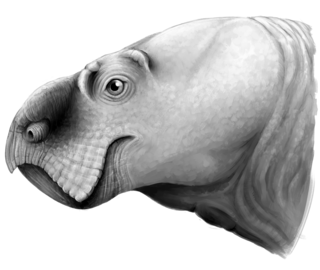
Ufudocyclops is an extinct genus of stahleckeriid dicynodont from the Middle Triassic of South Africa. It was found in the Burgersdorp Formation, part of the uppermost Cynognathus Assemblage Zone of the Beaufort Group in the Karoo Basin. The type and only known species is U. mukanelai. It was a large, beaked herbivore like other Triassic dicynodonts, lacking tusks, and is mostly characterised by unique features of the skull. It is known from three specimens, two of which were previously referred to the Tanzanian dicynodont Angonisaurus. The separation of Ufudocyclops from Angonisaurus indicates that the Middle Triassic fauna of the Beaufort Group in South Africa was not part of a larger shared fauna with those of the Manda Beds in Tanzania, as was previously supposed, and suggests that they were separated as more localised faunas, possibly by geographic barriers or in time. Ufudocyclops then would have been a unique part of the uppermost Cynognathus Assemblage Zone in South Africa. It is also the oldest known member of the family Stahleckeriidae, and implies that the family was already diversifying in the Middle Triassic alongside other kannemeyeriiforms, not just in the Late Triassic after other families died out.
